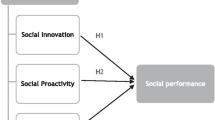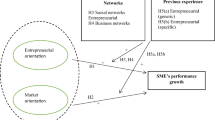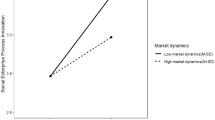Abstract
Market orientation has been presented as an important predictor of business performance, and it is presumed to contribute to long-term success in both profit-oriented and non-profit enterprises. Similarly, entrepreneurial orientation is a concept that has been widely applied to business firms but has not been empirically tested in social enterprises. Moreover, the literature does not present a widely accepted and tested conceptual model relating entrepreneurial orientation, market orientation and performance, in the realm of social enterprises. In order to fill this gap, this research assesses how these strategic orientations affect social and economic performance in the setting of social enterprises. Structural equation modeling was used as a means to analyze the hypothesized relationships. After testing the model on a sample of 805 Portuguese social enterprises, the findings show that both social entrepreneurship and market orientations significantly impact social performance. The results also indicate that market orientation mediates the effect of social entrepreneurship orientation on the performance of social enterprises.
Similar content being viewed by others
Notes
IPSS are non-profit private institutions, set up on the initiative of private individuals, which aim to solve social problems in Portugal.
Their purpose is giving individuals an organized expression to the moral duty of solidarity and justice. IPSS, which are not administered by the State or by any regional or local government institution, pursue the following objectives, among others:
• Provide support for children and adolescents;
• Provide support to families;
• Provide protection to the elderly and disabled citizens and in all situations of lack or reduction of means of subsistence or work capacity;
• Provide health promotion and protection, namely through the provision of preventive, curative and rehabilitation medical support;
• Provide citizens with education and professional training;
• Provide solutions to the population’s housing problems.
References
Amin, M., Ramayah, T., Mohammed, A., & Kaswuri, A. H. (2016). The effect of market orientation as a mediating variable in the relationship between entrepreneurial orientation and SMEs performance. Nankai Business Review International, 7(1), 39–59.
Arena, M., Azzone, G., & Bengo, I. (2015). Performance measurement for social enterprises. VOLUNTAS: International Journal of Voluntary and Nonprofit Organizations, 26(2), 649–672.
Avlonitis, G. J., & Gounaris, S. P. (1999). Marketing orientation and its determinants: an empirical analysis. European Journal of Marketing, 33(11/12), 1003–1037.
Bagnoli, L., & Megali, C. (2011). Measuring performance in social enterprises. Nonprofit and Voluntary Sector Quarterly, 40(1), 149–165.
Baker, W. E., & Sinkula, J. M. (2009). The complementary effects of market orientation and entrepreneurial orientation on profitability in small businesses. Journal of Small Business Management, 47(4), 443–464.
Baptista, N., Pereira, J., Moreira, A. C., & Matos, N. (2019). Exploring the meaning of social innovation: A categorisation scheme based on the level of policy intervention, profit orientation and geographical scale. Innovation, 21(3), 379–397.
Becker, J. M., Klein, K., & Wetzels, M. G. M. (2012). Hierarchical latent variable models in PLS-SEM: Guidelines for using reflective-formative type models. Long Range Planning, 45(5–6), 359–394.
Bennett, R. (2008). Marketing of voluntary organizations as contract providers of national and local government welfare services in the UK. VOLUNTAS: International Journal of Voluntary and Nonprofit Organizations, 19(3), 268–295.
Bhattarai, C., Kwong, C., & Tasavori, M. (2019). Market orientation, market disruptiveness capability and social enterprise performance: An empirical study from the United Kingdom. Journal of Business Research, 96, 47–60.
Cajaiba-Santana, G. (2014). Social innovation: Moving the field forward. A conceptual framework. Technological Forecasting and Social Change, 82, 42–51.
Cano, C. R., Carrillat, F., & Jaramillo, F. (2004). A meta-analysis of the relationship between market orientation and business performance: evidence from five continents. International Journal of Research in Marketing, 21(2), 179–200.
Chad, P. (2014). Organizational change within charities: improved performance via introduction of market orientation and other strategic orientations. International Review on Public and Nonprofit Marketing, 11(1), 89–113.
Choi, S. B., & Williams, C. (2016). Entrepreneurial orientation and performance: mediating effects of technology and marketing action across industry types. Industry and Innovation, 23(8), 673–693.
Coombes, S. M., Morris, M. H., Allen, J. A., & Webb, J. W. (2011). Behavioural orientations of non-profit boards as a factor in entrepreneurial performance: Does governance matter? Journal of Management Studies, 48(4), 829–856.
Covin, J. G., & Wales, W. J. (2012). The measurement of entrepreneurial orientation. Entrepreneurship: Theory and Practice, 36(4), 677–702.
Dawes, J. (2000). Market orientation and company profitability: Further evidence incorporating longitudinal data. Australian Journal of Management, 25(2), 173–199.
Defourny, J., & Nyssens, M. (2008). Social enterprise in Europe: Recent trends and developments. Social Enterprise Journal, 4(3), 202–228.
Defourny, J., & Nyssens, M. (2010). Social enterprise in Europe: At the crossroads of market, public policies and third sector. Policy and Society, 29(3), 231–242.
Deshpande, R., & Webster, F. E. (1989). Organizational culture and marketing: Defining the research agenda. Journal of Marketing, 53(1), 3–15.
Doherty, B., Haugh, H., & Lyon, F. (2014). Social enterprises as hybrid organizations: A review and research agenda. International Journal of Management Reviews, 16, 417–436.
Duque-Zuluaga, L. C., & Schneider, U. (2008). Market orientation and organizational performance in the nonprofit context: Exploring both concepts and the relationship between them. Journal of Nonprofit & Public Sector Marketing, 19(2), 25–47.
Germak, A. J., & Robinson, J. A. (2014). Exploring the motivation of nascent social entrepreneurs. Journal of Social Entrepreneurship, 5(1), 5–21.
González-Benito, Ó., González-Benito, J., & Muñoz-Gallego, P. A. (2009). Role of entrepreneurship and market orientation in firms’ success. European Journal of Marketing, 43(3/4), 500–522.
Grinstein, A. (2008). The relationships between market orientation and alternative strategic orientations: A meta-analysis. European Journal of Marketing, 42(1–2), 115–134.
Hair, J., Anderson, R., Tatham, R., & Black, W. (2010). Multivariate data analysis. Upper Saddle River, NJ: Prentice Hall.
Hair, J. F., Hult, G. T. M., Ringle, C., & Sarstedt, M. (2016). A primer on partial least squares structural equation modeling (PLS-SEM). London: SAGE Publications.
Hair, J., Sarstedt, M., Ringle, C., & Mena, J. (2012). An assessment of the use of partial least squares structural equation modeling in marketing research. Journal of the Academy of Marketing Science, 40(3), 414–433.
Henseler, J., Ringle, C. M., & Sinkovics, R. (2009). The use of partial least squares path modeling in international marketing. Advances in International Marketing, 20, 277–319.
Jarvis, C. B., MacKenzie, S. B., & Podsakoff, P. M. (2003). A critical review of construct indicators and measurement model misspecification in marketing and consumer research. Journal of Consumer Research, 30(2), 199–218.
Jaworski, B., & Kohli, A. (1993). Market orientation: Antecedents and consequences. The Journal of Marketing, 57(3), 53–70.
Kohli, A. K., & Jaworski, B. J. (1990). Market orientation: The construct, research propositions and managerial implications. Journal of Marketing, 54(1), 1–18.
Kohli, A. K., Jaworski, B. J., & Kumar, A. (1993). MARKOR: A measure of market orientation. Journal of Marketing Research, 30(4), 467–477.
Kraus, S., Niemand, T., Halberstadt, J., Shaw, E., & Syrjä, P. (2017). Social entrepreneurship orientation: Development of a measurement scale. International Journal of Entrepreneurial Behaviour and Research, 23(6), 977–997.
Kraus, S., Rigteringg, J., Hughes, M., & Hosman, V. (2012). Entrepreneurial orientation and the business performance of SMEs: A quantitative study from the Netherlands. Review of Managerial Science, 6(2), 161–182.
Lings, I. N., & Greenley, G. E. (2009). The impact of internal market orientations on firm performance. Journal of Strategic Marketing, 17, 41–53.
Lumpkin, G. T., & Dess, G. G. (1996). Clarifying the entrepreneurial orientation construct and linking it to performance. Academy of Management Review, 21(1), 135–172.
Ma, Y., Kim, M., Heo, J., & Jang, L. (2012). The effects entrepreneurship and market orientation on social performance of social enterprise. In International conference on economics marketing and management. (Vol. 28, pp. 60–65).
Matsuno, K., Mentzer, J. T., & Özsomer, A. (2002). The effects of entrepreneurial proclivity and market orientation on business performance. Journal of Marketing, 66(3), 18–32.
McNaughton, R. B., Osborne, P., & Imrie, B. C. (2002). Market-oriented value creation in service firms. European Journal of Marketing, 36(9/10), 990–1002.
Miles, M. P., Verreynne, M. L., & Luke, B. (2014). Social enterprises and the performance advantages of a Vincentian marketing orientation. Journal of Business Ethics, 123(4), 549–556.
Miller, D. (2011). Revisited: A reflection on EO research and some suggestions for the future. Entrepreneurship: Theory and Practice, 35(5), 873–894.
Montiel-Campos, H. (2018). Entrepreneurial orientation and market orientation. Journal of Research in Marketing and Entrepreneurship, 20(2), 292–322.
Narver, J. C., & Slater, S. F. (1990). The effect of a market orientation on business profitability. Journal of Marketing, 54(4), 20–35.
Nicholls, J., Lawlor, E., Neitzer, E., & Goodspeed, T. (2009). A guide to social return on investment. London: New Economics Foundation.
Niculescu, M., Xu, B., Hampton, G., & Peterson, R. (2013). Market orientation and its measurement in universities. Administrative Issues Journal Education Practice and Research, 3(2), 72–87.
Popoviciu, I., & Popoviciu, S. A. (2011). Social entrepreneurship, social enterprise and the principles of a community of practice. Revista de Cercetare si Interventie Sociala, 33(1), 44–55.
Rauch, A., Wiklund, J., Lumpkin, G. T., & Frese, M. (2009). Entrepreneurial orientation and business performance: An assessment of past research and suggestions for the future. Entrepreneurship: Theory and Practice, 33(3), 761–787.
Ringle, C. M., Sarstedt, M., & Straub, D. W. (2012). A critical look at the use of PLS-SEM in MIS quarterly. MIS Quarterly, 36(1), iii–xiv.
Roskos, S., & Klandt, H. (2007). Young technology ventures in Europe: Aspects of market orientation and entrepreneurial orientation. International Journal of Entrepreneurship and Small Business, 4(5), 543–563.
Rucker, D. D., Preacher, K., Tormala, Z., & Petty, R. (2011). Mediation analysis in social psychology: Current practices and new recommendations. Social and Personality Psychology Compass, 5(6), 359–371.
Schmidt, H. J., Baumgarth, C., Wiedmann, K.-P., & Lückenbach, F. (2015). Strategic orientations and the performance of Social Entrepreneurial Organisations (SEOs): A conceptual model. Social Business, 5(2), 131–155.
Wales, W. J. (2016). Entrepreneurial orientation: A review and synthesis of promising research directions. International Small Business Journal: Researching Entrepreneurship, 34(1), 3–15.
Yunus, M., Moingeon, B., & Lehmann-Ortega, L. (2010). Building social business models: Lessons from the Grameen experience. Long Range Planning, 43(2/3), 308–325.
Zhao, X., Lynch, J. G., & Chen, Q. (2010). Reconsidering Baron and Kenny: Myths and truths about mediation analysis. Journal of Consumer Research, 37(2), 197–206.
Zhou, K., Brown, J., & Dev, C. (2009). Market orientation, competitive advantage, and performance: A demand-based perspective. Journal of Business Research, 62(11), 1063–1070.
Author information
Authors and Affiliations
Corresponding author
Ethics declarations
Conflict of Interest
The authors declare that they have no conflict of interest.
Informed consent
All respondents have given informed consent to participate in the survey.
Additional information
Publisher's Note
Springer Nature remains neutral with regard to jurisdictional claims in published maps and institutional affiliations.
Appendices
Appendix 1: Measurement scales\
Intelligence generation |
We meet with our beneficiaries at least once a year to better understand their needs |
We meet with our stakeholders at least once a year to better understand their needs |
We understand the role of social enterprises in the current economic and political context |
We make satisfaction surveys (beneficiaries, stakeholders or others) at least once a year |
We have various ways of collecting information about our environment (with beneficiaries, stakeholders, etc.) |
We monitor changes in the economy, society, technology and political-legal system, in order to understand how they can affect us |
We regularly compare the performance we think we have with the performance perceived by our stakeholders |
We regularly analyze the factors that influence the beneficiaries’ decision to choose us instead of companies with similar missions |
We collect the opinion of our beneficiaries through social networks |
Intelligence Dissemination |
We share information and cooperate with organizations with a similar mission |
We disseminate the information collected (with beneficiaries, stakeholders, etc.) throughout the organization |
We have regular team meetings to discuss important operational and strategic changes |
We have a business model/business plan that is clearly perceived by employees and stakeholders |
We use social networks to communicate regularly among employees |
Responsiveness |
We have enough information available to develop appropriate products/services for our beneficiaries |
We use all available information to adjust or develop products/services for our beneficiaries |
We try to respond to the emerging needs of beneficiaries or stakeholders |
We adapt our strategies according to the needs of our beneficiaries |
We adapt our strategies according to the expectations of our stakeholders |
We try to differentiate our services from other alternatives |
We invest significantly in marketing and communication |
Appendix 2
Innovativeness |
Social innovation is important for our company |
We invest heavily in developing new ways to increase our social impact or to serve our beneficiaries |
In our company, new ideas to solve social problems come up very frequently |
Risk-taking |
We are not afraid to take substantial risks when serving our social purpose |
Bold action is necessary to achieve our company’s social mission |
We avoid the cautious line of action if social opportunities might be lost that way |
Proactiveness |
We are not afraid to take substantial risks when serving our social purpose |
Bold action is necessary to achieve our company’s social mission |
We avoid the cautious line of action if social opportunities might be lost that way |
Socialness |
The objective to accomplish our social mission precedes the objective to generate a profit |
Our organization places a strong focus on partnerships with other organizations and/or governments in order to ensure a greater and accelerated accomplishment of the social mission |
We set ourselves ambitious goals in regard to sustainability and incorporate them in all strategic decisions |
Appendix 3
Social performance |
We operate our organization in an environmentally sustainable manner |
Our donors are very satisfied with us |
Our organization operates in a socially sustainable manner |
We help inform the community about the plight of our beneficiaries |
We help mobilize interest for additional social welfare initiatives |
We are often perceived and valued by our beneficiaries as a provider of last resort |
In the past few years we have met our objectives in terms of beneficiaries served. Beneficiaries are satisfied with our services |
Beneficiaries and stakeholders recommend our services to others |
Economic performance |
We are more effective in serving our beneficiaries than others |
In the past few years we have increased our effectiveness. |
We are more efficient in serving our beneficiaries than others. |
In the past few years we have increase our efficiency. |
In the past few years our financial situation has improved |
Our organization is financially sustainable |
Rights and permissions
About this article
Cite this article
Pinheiro, P., Daniel, A. & Moreira, A. Social Enterprise Performance: The Role of Market and Social Entrepreneurship Orientations. Voluntas 32, 45–60 (2021). https://doi.org/10.1007/s11266-020-00266-x
Published:
Issue Date:
DOI: https://doi.org/10.1007/s11266-020-00266-x









